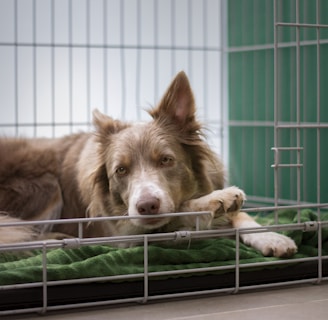Disclosure: Some ads may contain affiliate links. I may earn a commission if you make a purchase, at no extra cost to you.
The Pros & Cons of Crate Training Your Dog
In this blog, we’ll explore the positives and negatives of crate training so you can decide if it’s right for your furry friend.
PET WELLBEING
4/2/20253 min read


The Pros and Cons of Crate Training Your Dog
If you're a new dog owner or considering crate training, you’ve probably heard strong opinions on both sides. Some people swear by it, while others think it’s cruel. The truth? Crate training can be a fantastic tool—when used correctly—but it’s not the perfect solution for every dog or situation.
In this blog, we’ll explore the positives and negatives of crate training so you can decide if it’s right for your furry friend.
The Positives of Crate Training
1. Provides a Safe, Den-Like Space
Dogs are den animals by nature, meaning they often seek out small, cozy spaces to relax. A properly sized crate can become their own little sanctuary—somewhere they feel secure and comfortable. Many dogs voluntarily retreat to their crates for naps or downtime.
2. Aids in Potty Training
Dogs naturally avoid soiling their sleeping area, making crates a useful tool for housebreaking. By keeping your pup in a crate when you can’t supervise them, you encourage them to hold their bladder until they’re taken outside. Over time, this helps establish a routine.
3. Prevents Destructive Behavior
Puppies (and even some adult dogs) love to chew, dig, and explore—sometimes in ways that destroy your favorite shoes or furniture. A crate keeps them safe from mischief when you’re not around to redirect them.
4. Helps with Travel & Vet Visits
If your dog is comfortable in a crate, traveling (whether by car or plane) becomes much easier. Many vets and groomers also use crates, so a dog who’s already crate-trained will be less stressed in these situations.
5. Eases Separation Anxiety (For Some Dogs)
For dogs who struggle with separation anxiety, a crate can provide structure and security. Knowing they have a designated safe space can reduce stress when left alone.
The Negatives of Crate Training
1. Can Feel Like Punishment if Misused
If a dog is forced into a crate for too long or without proper training, they may associate it with isolation or punishment. This can lead to fear, anxiety, and even resistance to entering the crate.
2. Risk of Overuse
A crate should never be a dog’s primary living space. Dogs need exercise, socialization, and mental stimulation. Leaving them crated for more than 4-6 hours at a time (depending on age and breed) can lead to boredom, frustration, and even physical issues like muscle stiffness.
3. Not All Dogs Adapt Well
Some dogs, especially rescues with past trauma, may never feel comfortable in a crate. Forcing the issue can worsen anxiety or lead to escape attempts (which can be dangerous if they injure themselves).
4. Potential for Accidents if Left Too Long
While crates help with potty training, puppies and small dogs have limited bladder control. If left crated too long, they may have accidents, which can set back training and create negative associations.
5. Can Be Expensive & Take Up Space
Good crates aren’t cheap, and they can be bulky in small homes. You may need multiple sizes as your puppy grows, adding to the cost.
Tips for Responsible Crate Training
If you decide crate training is right for your dog, follow these best practices:
✅ Introduce the crate gradually – Let your dog explore it with treats and praise before closing the door.
✅ Never use the crate as punishment – It should always be a positive space.
✅ Keep crate time reasonable – Puppies need frequent breaks (every 2-3 hours).
✅ Make it comfy – Add a soft bed, toys, and maybe a blanket with your scent.
✅ Provide alternatives – If your dog hates the crate, consider a playpen or gated safe space instead.
Final Thoughts: Is Crate Training Right for Your Dog?
Crate training isn’t a one-size-fits-all solution. For many dogs, it’s a lifesaver—helping with training, safety, and comfort. For others, it may cause more stress than good.
The key? Pay attention to your dog’s needs. If they’re happy, relaxed, and well-adjusted with crate training, great! If not, there are other ways to manage their behavior.
If you are looking to crate your Pup head over to our review page where we look at Top 7 Dog Crates for Large Breed Dogs & Puppies in the UK (2025) – Best Picks for Home & Travel.
What’s your experience with crate training? Love it or hate it?
Meo's world
<--Awin verification 001-->
Bark
Fetch
meosworld@yahoo.com
© Meo's World 2025. All rights reserved.


